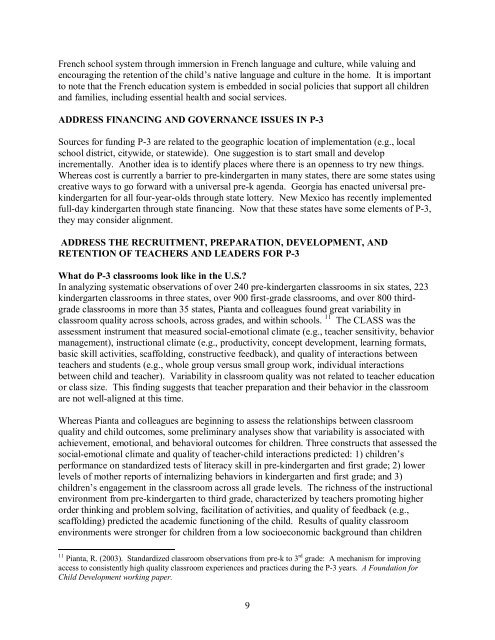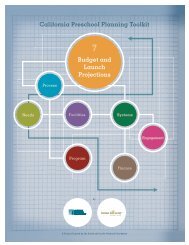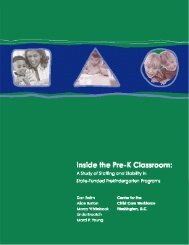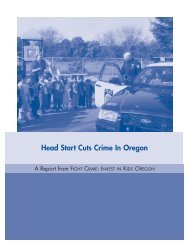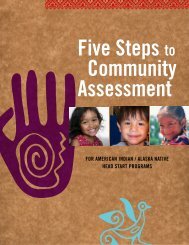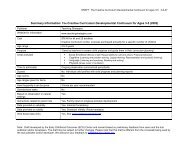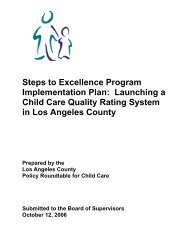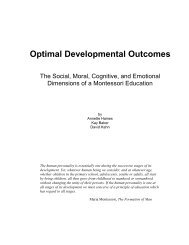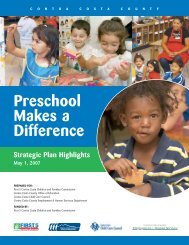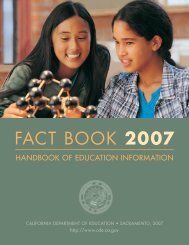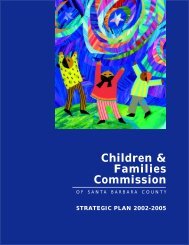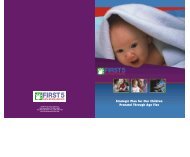Mapping the P-3 Continuum - Foundation for Child Development
Mapping the P-3 Continuum - Foundation for Child Development
Mapping the P-3 Continuum - Foundation for Child Development
Create successful ePaper yourself
Turn your PDF publications into a flip-book with our unique Google optimized e-Paper software.
French school system through immersion in French language and culture, while valuing andencouraging <strong>the</strong> retention of <strong>the</strong> child’s native language and culture in <strong>the</strong> home. It is importantto note that <strong>the</strong> French education system is embedded in social policies that support all childrenand families, including essential health and social services.ADDRESS FINANCING AND GOVERNANCE ISSUES IN P-3Sources <strong>for</strong> funding P-3 are related to <strong>the</strong> geographic location of implementation (e.g., localschool district, citywide, or statewide). One suggestion is to start small and developincrementally. Ano<strong>the</strong>r idea is to identify places where <strong>the</strong>re is an openness to try new things.Whereas cost is currently a barrier to pre-kindergarten in many states, <strong>the</strong>re are some states usingcreative ways to go <strong>for</strong>ward with a universal pre-k agenda. Georgia has enacted universal prekindergarten<strong>for</strong> all four-year-olds through state lottery. New Mexico has recently implementedfull-day kindergarten through state financing. Now that <strong>the</strong>se states have some elements of P-3,<strong>the</strong>y may consider alignment.ADDRESS THE RECRUITMENT, PREPARATION, DEVELOPMENT, ANDRETENTION OF TEACHERS AND LEADERS FOR P-3What do P-3 classrooms look like in <strong>the</strong> U.S.?In analyzing systematic observations of over 240 pre-kindergarten classrooms in six states, 223kindergarten classrooms in three states, over 900 first-grade classrooms, and over 800 thirdgradeclassrooms in more than 35 states, Pianta and colleagues found great variability inclassroom quality across schools, across grades, and within schools. 11 The CLASS was <strong>the</strong>assessment instrument that measured social-emotional climate (e.g., teacher sensitivity, behaviormanagement), instructional climate (e.g., productivity, concept development, learning <strong>for</strong>mats,basic skill activities, scaffolding, constructive feedback), and quality of interactions betweenteachers and students (e.g., whole group versus small group work, individual interactionsbetween child and teacher). Variability in classroom quality was not related to teacher educationor class size. This finding suggests that teacher preparation and <strong>the</strong>ir behavior in <strong>the</strong> classroomare not well-aligned at this time.Whereas Pianta and colleagues are beginning to assess <strong>the</strong> relationships between classroomquality and child outcomes, some preliminary analyses show that variability is associated withachievement, emotional, and behavioral outcomes <strong>for</strong> children. Three constructs that assessed <strong>the</strong>social-emotional climate and quality of teacher-child interactions predicted: 1) children’sper<strong>for</strong>mance on standardized tests of literacy skill in pre-kindergarten and first grade; 2) lowerlevels of mo<strong>the</strong>r reports of internalizing behaviors in kindergarten and first grade; and 3)children’s engagement in <strong>the</strong> classroom across all grade levels. The richness of <strong>the</strong> instructionalenvironment from pre-kindergarten to third grade, characterized by teachers promoting higherorder thinking and problem solving, facilitation of activities, and quality of feedback (e.g.,scaffolding) predicted <strong>the</strong> academic functioning of <strong>the</strong> child. Results of quality classroomenvironments were stronger <strong>for</strong> children from a low socioeconomic background than children11 Pianta, R. (2003). Standardized classroom observations from pre-k to 3 rd grade: A mechanism <strong>for</strong> improvingaccess to consistently high quality classroom experiences and practices during <strong>the</strong> P-3 years. A <strong>Foundation</strong> <strong>for</strong><strong>Child</strong> <strong>Development</strong> working paper.9


